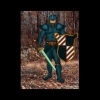I Everyone,
I am having an issue with the textures of quads getting mixed up when drawing armor pieces on my characters.
When drawing an Helm on top of a head, in the distance, the texture of the head seems to overlap the texture of the helm.
The quads on each model piece (head and helm) are at different Z, they are not flush, usually a difference of about 0.05f.
Anybody has a tip on how to deal with that issue?
Thanks a lot.






